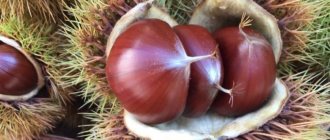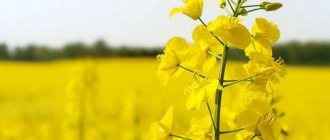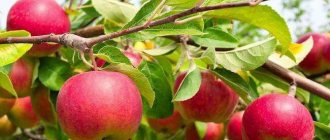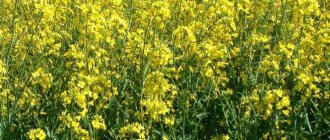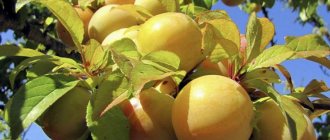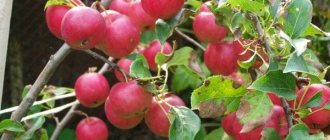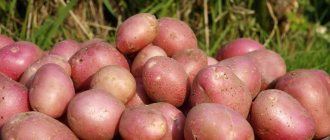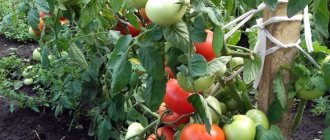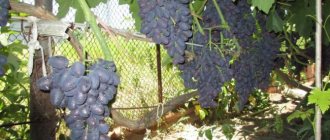The lifespan of the plant reaches three hundred years; an adult tree can have a height of 25 to 40 meters. The crown of the tree is oval in shape and is formed by large five- or seven-fingered leaves, which are located opposite. Since chestnut is a deciduous tree, the process of falling leaves begins in the fall.
The flowering period begins in May: inflorescences with 20-50 white-pink flowers appear on the tree, which emit an intense aroma.
By the end of summer, the fruits ripen on the tree: they are capsules in type, they are light green in color and dotted with numerous thorns.
Inside is a seed: most often one; Less common are boxes with two or three seeds. This seed is called a chestnut, and it looks like a brown nut with a white scar.
The color of the fruit is similar to the color of a bay horse, and the white scar resembles a hoof mark: thanks to these associations, the tree got its name.
The ripe fruit falls off and the capsule begins to open. The light green color of the peel changes to brown, gradually it breaks into pieces and releases the seed.
There are edible species of this tree, but the fruit of the horse chestnut is poisonous. Externally, edible and inedible seeds are similar, so it is important to know what horse chestnut looks like to eliminate the risk of poisoning.
Chemical composition
- Flavone glycosides. Useful in the fight against tumors and inflammation.
- Escin. This substance normalizes venous blood flow and relieves swelling.
- Purines. Support metabolism, help absorb micro- and macroelements.
- Vitamins B1, B4, C, K.
- Tannins heal cuts, help with throat diseases and are used as an antidote.
- Allantoin is often found in cosmetics.
Esculus
Found in forests and parks of many regions of Russia. This fruit of the Sapindaceae family is larger and single. In the Middle Ages it was used as a nutritious feed for horses, allowing them to quickly restore strength.
Bitter, toxic, but in many ways it is more useful than its food counterpart.
Widely used in medicine. The source of raw material is most parts of this tree. To harvest it, it is more advisable to cut off the bark in early spring, and collect flowers and leaves during flowering.
Beneficial features
Medicines based on chestnut can cope with increased body temperature, inflammation, swelling, and tumors. Horse chestnut is also an excellent pain reliever and bactericidal agent, healing abrasions and cuts. The substances in the composition have a beneficial effect on the walls of veins and blood vessels and have a venotonic and antithrombotic effect.
The medicinal properties of horse chestnut help slow down the aging process of the body and help prevent sclerosis.
Medicines from chestnut can be used in the treatment of radiation sickness, vein thrombosis, exacerbation of hemorrhoids, rhinitis, and throat diseases.
How to grow a peach from a pit - care, maintenance and technology for growing peach at home (95 photos)
Coniferous plants in landscape design: how to create a beautiful composition in your garden
Why plums do not bear fruit - 10 main reasons and tips for choosing a method of treating plums and restoring the harvest
The main problems of growing chestnuts
Horse chestnut is a completely unpretentious plant, but some health problems can occur.
The most common diseases:
- Hole spot appears in the form of small holes, which subsequently cover all leaf blades. The main reason is excessive humidity.
- Black spotting can be identified by the presence of black spots that increase in size over time.
- Red or brown spotting appears due to sudden changes in temperature or during summer drought. In this case, the leaf plates are completely covered with brown spots.
- Powdery mildew appears as a whitish coating on the upper part of the leaf blades. Essentially it is a fungus that quickly spreads throughout the plant and occurs due to high humidity.
You can combat all possible problems by correcting growing conditions, as well as using fungicides and insecticides.
Contraindications and precautions
Oral forms of the drug are contraindicated:
- hypotensive patients: the medicine will further lower blood pressure, and this can cause fainting and deterioration of well-being.
- for hemophilia.
- for gastritis with low acidity: chestnut has the ability to reduce the acidity of the stomach, so the remedy will not work.
- girls and women whose menstrual cycle is characterized by deviations from the norm - changes in the volume of blood loss, delays or absence of menstruation.
- children under 14 years of age.
Not for use during pregnancy and breastfeeding.
Before starting treatment, you should discuss your drug dosage regimen with your doctor.
Side effects include heartburn and nausea. Allergies may occur, so horse chestnut flowers are contraindicated for hay fever.
In case of overdose, cramps of the fingers occur.
Purchasing seeds in bulk: 3 signs of a reliable store
How to propagate plums: the best ways to grow, care and plant with your own hands. Video instructions and 120 photos
At what distance to plant grapes from each other: tips and recommendations from professionals on planting grapes on a personal plot (125 photos and videos)
The genus and its representatives
Olga Nikitina
The genus Horse chestnut (Aesculus) belongs to the horse chestnut family and has about 25 species distributed in Europe, Asia and North America. They are relatively frost-resistant, shade-tolerant, but develop better in good light. Most species are moisture-loving, quite resistant to pests and diseases, and prefer loamy soils containing lime.
Representatives of this genus are deciduous trees or shrubs with palmately compound, long-petioled leaves consisting of 5–9 leaflets, serrated along the edge. The flowers are quite large, bisexual, collected in pyramidal panicles 10–15 cm long. The petals have multi-colored spots, at first they are yellow, and then become orange and, finally, carmine red. Interestingly, a change in the color of a spot also correlates with a change in its smell. Yellow color is a signal for bees and butterflies, indicating the presence of nectar, and orange and red indicate its absence. The fruit is a spherical capsule with spikes, usually containing one large dark brown, polished seed.
The wood of horse chestnuts is diffusely vascular, white or cream, light, and in technical properties is close to the wood of poplar, alder and linden.
Horse chestnuts grow slowly, especially in the first ten years, and can withstand replanting until 15–20 years. All types are decorative during the growing season. Used in alleys, group and single plantings in parks, squares and city streets. Chestnuts can accumulate harmful sulfur compounds and lead.
They reproduce by sowing seeds in the fall or in the first spring after collecting them (preferably after stratification), as well as by grafting or budding onto common species.
Proper planting and care of plants is the key to their longevity and decorativeness. Horse chestnut prefers fertile soils; in hot weather, watering is required, otherwise a dry border will form along the edges of the leaves, spoiling the decorative appearance of the plant.
For alley and group plantings, the distance between trees should be at least 5–6 m. After planting, the soil settles and becomes compacted, so plants are planted to a depth at which the root ball will be 10–20 cm higher than recommended. This is especially important to observe when planting large specimens. As drainage, a 15–20 cm layer of coarse sand or crushed stone is poured into the planting hole.
The soil mixture should consist of turf and leaf soil and sand in a ratio of 2:1:1. If the soil is acidic, then lime must be added.
Watering is required not only during planting, but also for the next 3–4 days. In early spring, nitrogen-containing fertilizers are applied, and in the fall they are fed with mineral fertilizers (nitroammofoska). Pruning removes dry and diseased branches, as well as spiny shoots that sometimes form on the trunk.
The common cucumber (A. hippocastanum), growing in the south of the Balkan Peninsula, has become widespread in culture. A luxurious tree 30 m high with a tent-shaped crown and a powerful trunk up to 2 m in diameter, covered with gray-brown bark. Its blossoming leaves resemble huge dark green fans. Spread sparingly, they clearly demonstrate the phenomenon of leaf mosaics. At the beginning of summer, white candles of inflorescences “flare up” in the crown, the pyramidal shapes of which botanists call thyrsus.
This species is quite light- and moisture-loving, demanding soil richness. In autumn, when fruiting is abundant, it can litter sidewalks and paths with fallen fruits. During drought, the leaves warp and fall off.
Most species of horse chestnut grow naturally in the lowland and mountain forests of North America, many of which are used in our green building.
The unusual name of the genus is associated with the shape of the leaf trail, similar to a horseshoe. It is also reminiscent of a light spot on the dark brown skin of the seed.
The eight-stamen horse chestnut (A. octandra) is native to eastern North America. This is a large tree, 20–30 m high, with a trunk diameter of up to 2.5 m, and has a dense, broadly ovoid crown. The leaves are palmately compound, lighter than those of the previous species. The flowers are yellow, collected in pyramidal panicles, 10–15 cm long. The fruits are spherical capsules, up to 6 cm in diameter, non-thorny. It grows relatively quickly, is undemanding to soil, but short-lived in cultivation. It is considered a shade-tolerant species, but blooms weakly in shade, which affects its decorative value. Relatively winter-hardy, watering is required on dry soils.
Buckeye (A. glabra) is a tree 10–20 m tall, native to southern Nebraska, Iowa and Pennsylvania, as well as the western slopes of the Appalachian Mountains. It has a through crown, graceful, smooth foliage and fruits with soft thorns, later with tubercles. Pale greenish-yellow flowers are collected in pyramidal panicles up to 18 cm long.
Widespread in culture is red meat (A. x carnea). This is a tree 15–25 m high, of hybrid origin; the hybrid was obtained by crossing the common horse chestnut and the pavia horse chestnut. It looks spectacular during flowering, as it has flowers of various colors (from pink to dark red), collected in paniculate inflorescences up to 20 cm long. It begins to bloom earlier than the common horse chestnut, the flowering period is 20 days. In autumn the leaves remain green for a long time. Red meat horse chestnut is very sensitive to air and soil dryness. It is considered one of the most decorative species.
Horse chestnut pavia (A. pavia) is a tree from 6 to 12 m in height, sometimes growing as a bush. The leaves are graceful, twice as small as those of the common horse chestnut, narrowly elliptical. It is distinguished by bright red flowers, collected in loose panicles up to 16 cm long. The fruits are small spherical boxes with tubercles. It is a less frost-resistant species than the common horse chestnut, but in places well protected from the wind it grows as a shrub, blooms and bears fruit.
Very interesting is A. parviflora, which is a beautiful densely branched shrub 4–5 m high. Sometimes this species can form entire thickets. The leaves are palmate and have grayish pubescence below. White small, up to 1 cm, flowers are collected in luxurious cylindrical panicles up to 40 cm long. Pink-white stamens, which are twice as long as the petals, add piquancy to the flowers. This type of chestnut is not frost-resistant enough; in central Russia it requires shelter for the winter, but in the southern regions it feels excellent if it is watered abundantly during droughts. It is of interest as a bush-like, late-blooming species of chestnut that looks good in single and group plantings.
Chinese horse chestnut (A. chinensis) is one of the few species native to China. This is a tree up to 15 m high, with bare young branches. White flowers with red-yellow spots on the petals are collected in panicles up to 20 cm long and 5.5 cm wide. The fruit is a slightly flattened, almost spherical capsule, 2–2.5 cm in diameter. Not frost-resistant enough; in central Russia it requires winter shelter.
Horse chestnuts are not only ornamental and melliferous, but also medicinal plants.
| Common horse chestnut Flowering of the common horse chestnut Fruit of the common horse chestnut Small-flowered horse chestnut Eight-stamened horse chestnut Flowering of meat-red horse chestnut Blooming horse chestnut bud Small-flowered horse chestnut flowering Eight-stamen horse chestnut |
Collection recommendations
In order for horse chestnut to retain all its beneficial properties, it must be collected and prepared correctly. There are different harvesting rules for different parts, but it is important to remember that only trees with white flowers are suitable for this purpose.
The bark becomes suitable for harvesting in early spring. Young bark is suitable for collection; it is best to cut it from the branches. Pieces of bark are cut into small pieces and sent to dry in a dark, ventilated place.
The bark retains its medicinal properties for two years when stored in bags made of natural fabric or in rolls of thick paper.
The beginning of flowering is the time to collect flowers. There is no need to pluck the entire inflorescence from the branch: just pick off individual flowers. They are laid out one at a time and then placed in a place with constant air humidity to prevent rotting. The beneficial properties of chestnut flowers last up to two years.
The leaves are harvested in May; only individual leaves need to be picked; petioles are not needed. To dry, chestnut leaves are carefully laid out in a ventilated, dark place, and after drying, stored in tightly closed glass containers.
Gooseberry health benefits and harms: beneficial properties for the body and description of the contents of the berry (115 photos + video)
Red currant care and cultivation: varieties, pruning, planting and propagation rules at home (115 photos)
Black elderberry: planting, watering, pruning and propagation. Contraindications, medicinal properties and recipes for feeding elderberry (110 photos)
The fruits are harvested in early autumn, when they are fully ripe. Of great value are already fallen seeds with an open and darkened capsule. They are dried and stored in a closed container.
Description of the plant - photo
Horse chestnut trees can often be found in garden plots or park areas. It is a fairly tall tree with opposite leaves. The shape of the chestnut leaf is pointed with small teeth along the edges. You can see what a horse chestnut leaf looks like in the photo.
How do these trees bloom? The flowering process begins in late spring. The flowers are white or pale pink, they form in large erect clusters, reaching 30 cm in length. At the beginning of autumn, the first fruits begin to appear on the tree. They are small round-shaped boxes covered with large thorns. Inside these boxes are irregularly shaped seeds that are brown in color and have a glossy surface. You can see what the horse chestnut fruit looks like in the photo.
Where does this tree grow? Most often it can be found in Russia, Ukraine, Central Asia, and the Caucasus. Greece is considered the birthplace of this plant.
Recipes for diseases
Haemorrhoids. Pour 50 g of bark into a liter of hot water and boil for 15 minutes. Leave for 8 hours. Take a bath with the infusion after defecation for 15 minutes.
Joint pain: 1.5 tbsp. l. dried chestnut flowers per 0.5 l. vodka. Leave for two weeks, then use for rubbing.
Gout: 40 gr. flowers per 1 liter. medical alcohol. Infuse for a week. Use as compresses.
Leukemia: 8 tbsp. l. pour dried flowers into a liter of water, as soon as the water boils, pour the infusion into a jar and leave to infuse for 8 hours, divide the finished product into 5 doses, drink throughout the day.
Bath for dermatological diseases: mix dried leaves, flowers and bark and pour boiling water over it. Leave for 12 hours. A bath with infusion is taken for up to 20 minutes.
Inflammation of veins: 300 gr. fruits per 1 liter. vodka. After 7 days, gently rub the inflamed areas with the tincture.
Varicose veins, hemorrhoids: 50 gr. seeds per 500 ml. vodka. Leave for 7 days. Take no more than 10 drops 3 times a day.
To relieve inflammation and swelling, oil or ointment is also used externally. To prepare, mix fruits and flowers ground into powder. The oil base can be any unrefined vegetable oil. Bring to a boil in a water bath and simmer for an hour.
In order to obtain the ointment, you need to melt 200 g of solid fat in a water bath, add 5 finely chopped seeds and a pinch of flowers to the container, and after boiling, add 20 g. beeswax. The frozen ointment is ready for use.
To treat chronic diarrhea, diseases of the nose and throat, an infusion is prepared: 2 crushed fruits per glass of boiling water. In 2 hours the medicine will be ready. It is taken 5 times a day, 2 tbsp. l.
Planting and caring for sprouts
A container is prepared for planting: expanded clay must be poured onto the bottom as a drainage layer, then a layer of fertile soil is placed on top. Suitable soil taken from a garden plot or park.
Next, the germinated fruit is planted to a depth of about 2 cm. It is not recommended to go deeper, since it will take a very long time to germinate, and if planted on the surface, the fragile sprout may dry out.
You can keep the plant at home for about a year. With the onset of spring warmth, it is advisable to place the container in the open air, in a shaded place, to protect the plant from direct sunlight. But we must not forget about watering, since the soil dries out quickly in the pot, and fertilize it 2 times a month; complex flower fertilizers are suitable for this purpose.
With the onset of cold weather, it is better to bring the pot indoors, provide it with a cooler temperature and water it moderately.
Drop off location
In spring, it is recommended to plant a small tree in a permanent place of growth. To do this, you need to choose a well-lit area, protected from drafts.
You need to properly prepare the hole where the chestnut will grow. This is done like this:
- A drainage layer is poured.
- Then you should add a little slaked lime.
- Next, the land is fertile.
The seedling is transferred into the resulting hole; after planting, it is advisable to water the plant abundantly and, especially at first, monitor the soil moisture.
Watering and fertilizing
Care is carried out in the same way as for other plants: you need to apply fertilizers in a timely manner, loosen the soil and remove weeds. The tree has a fairly developed root system, so it should be watered with plenty of liquid. If the summer is hot, it is necessary to water at least once every 30 days, using about 10 liters of water.
If you want to plant several trees, then you need to maintain an interval of about 4-5 meters between them, since mature chestnuts have a rather lush crown.
The best time for fertilizing is spring; you can prepare good fertilizer on your own. The required "ingredients" are:
- Water (three 5-liter buckets).
- Manure - 1 kg.
- Ammonium nitrate - 10 g.
- Urea - 15 g.
You should also add a complex fertilizer containing potassium, nitrogen and phosphorus; take 25 g of it. The resulting mixture is used to moisten the soil under the tree.
As winter approaches, it is recommended to cover young chestnut seedlings with fallen leaves and burlap. Spring is the best time to trim diseased, dry branches and form a neat crown. This will rejuvenate the plant and extend its life.
Application in cosmetology
Thanks to their anti-inflammatory and restorative effects, flowers can be used in cosmetology. The prepared floral ointment cares for the skin of the face and décolleté. The ointment can also whiten the skin.
It is prepared like this: 2.5 tbsp. l. dried chestnut flowers mixed with 100 ml. vegetable oil and boil for half an hour in a water bath. After straining, the ointment can be used.

